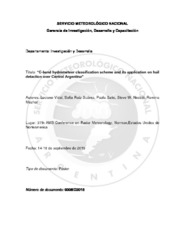Mostrar el registro sencillo del ítem
C-band hydrometeor classification scheme and its application on hail detection over Central Argentina
| dc.contributor.author | Vidal, Luciano | |
| dc.contributor.author | Ruiz Suárez, Sofía | |
| dc.contributor.author | Salio, Paola | |
| dc.contributor.author | Nesbitt, Steve | |
| dc.contributor.author | Mezher, Romina | |
| dc.date.accessioned | 2017-02-14T15:44:27Z | |
| dc.date.available | 2017-02-14T15:44:27Z | |
| dc.date.issued | 2015-09-14 | |
| dc.identifier.uri | http://hdl.handle.net/20.500.12160/119 | |
| dc.description | Trabajo presentado en la 37th AMS Conference on Radar Meteorology, en Norman-Estados Unidos de Norteamerica, del 14 al 18 de septiembre de 2015. | es |
| dc.description.abstract | Central Argentina is one of the most favorable regions for strong mesoscale convective systems in the world, especially during austral warm season. High impact weather events associated with these convective systems are flash flood, strong winds, hail, and tornadoes. Dual-polarized weather radars may offer the opportunity to detect and i dentify different classes of hydrometeors present in convective storms. In particular, hydrometeor classification helps to detect hail shafts within storms, thus providing valuable information for nowcasting applications, flight assistance, among others. Argentina has an increasing C-band polarimetric weather radar network developed with local resources by SiNaRaMe project. In the next three years this network will be expanded by the addition of ten new radars in different mid-latitude climate regions. Previous works presented hydrometeor classification algorithms for C-band radars, but these evaluations were performed principally in tropical climate regimes (e.g., Darwin in Australia). It is important to explore about the performance of these algorithms for the identification of hail in mid-latitude intense convection over C-band radars. The aim of this study is to explore the application of a hydrometeor identification scheme for C band based on a fuzzy-logic approach over the central part of Argentina. The algorithm is evaluated using surface damage report corresponding to three severe hailstorm events detected within the area of the Anguil polarimetric radar (36.54S, 63.99W). Preliminary results of the performance of the classification algorithm will be discussed. Emphasis will be placed on evaluating the performance of the algorithm considering available surface reports as validation. A strict multi-step quality control evaluation and attenuation correction protocol is performed before hydrometeor identification to validate input variables, which suffer from significant non- Rayleigh resonant effects over these extreme cases. | es |
| dc.language.iso | eng | es |
| dc.publisher | Servicio Meteorológico Nacional. Gerencia de Investigación Desarrollo y Capacitación. Departamento de Investigación y Desarrollo | es |
| dc.subject | SISTEMAS CONVECTIVOS DE MESOESCALA | es |
| dc.subject | VERANO AUSTRAL | es |
| dc.subject | C-BAND | es |
| dc.subject | HYDROMETEORS | es |
| dc.subject | CLASSIFICATION | es |
| dc.subject | CRECIDAS REPENTINAS | es |
| dc.subject | RADARES METEOROLÓGICOS DE POLARIZACIÓN DUAL | es |
| dc.subject | TORNADOS | es |
| dc.title | C-band hydrometeor classification scheme and its application on hail detection over Central Argentina | es |
| dc.type | Working Paper | es |
